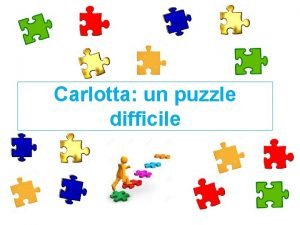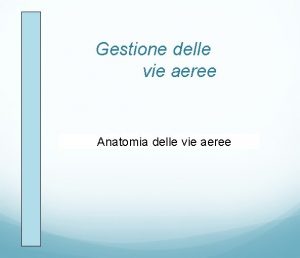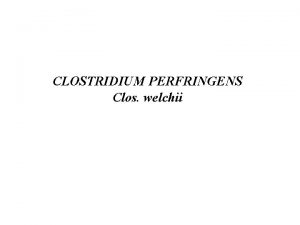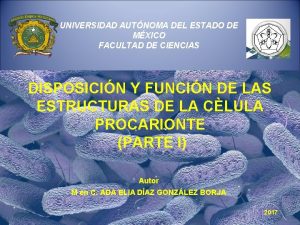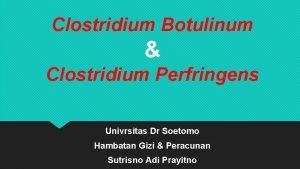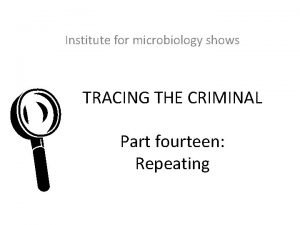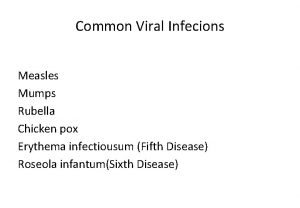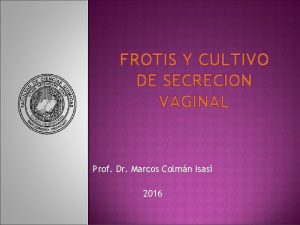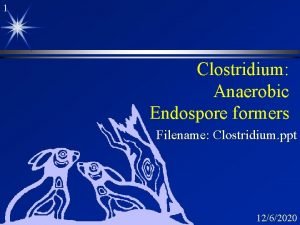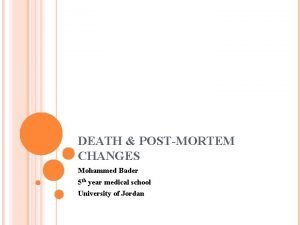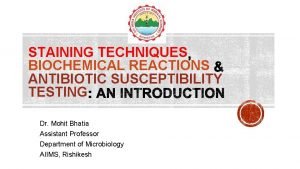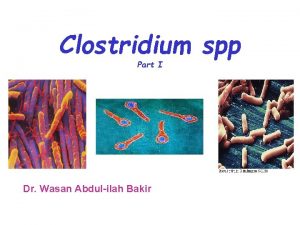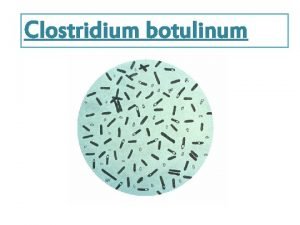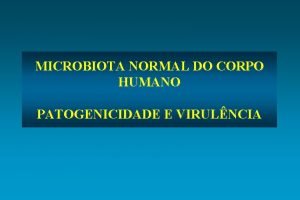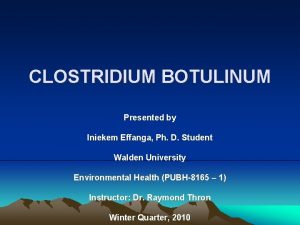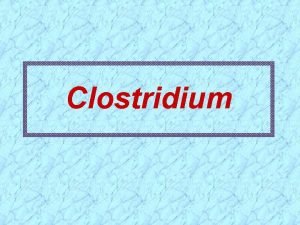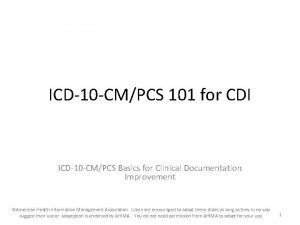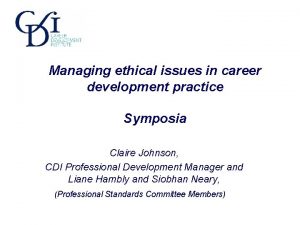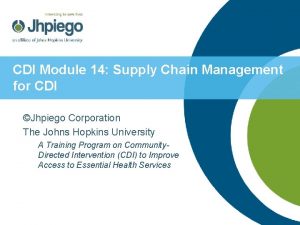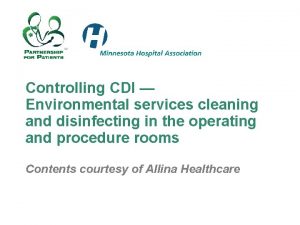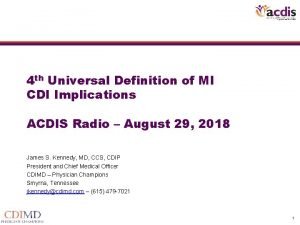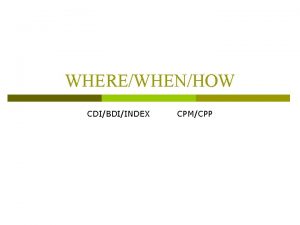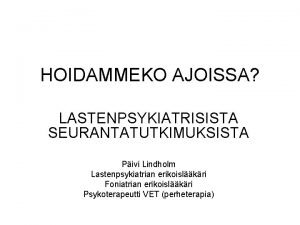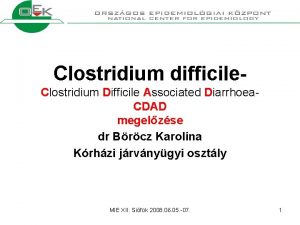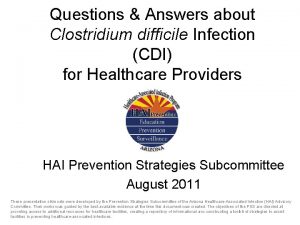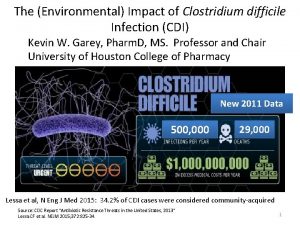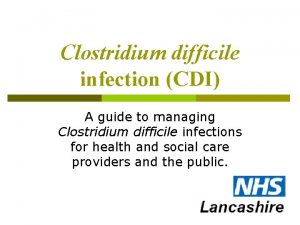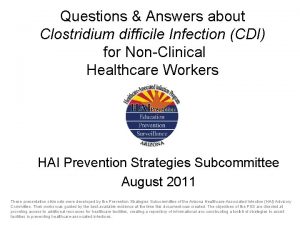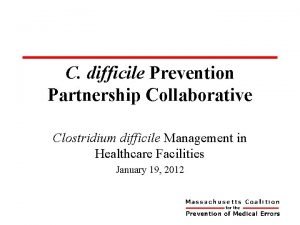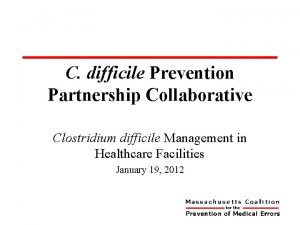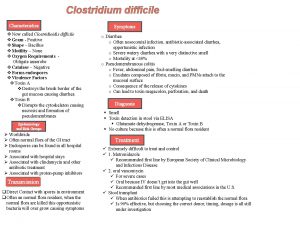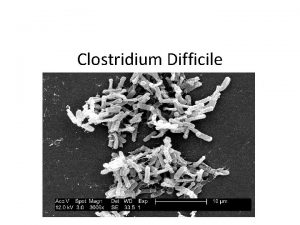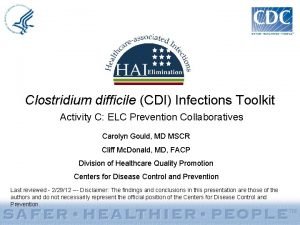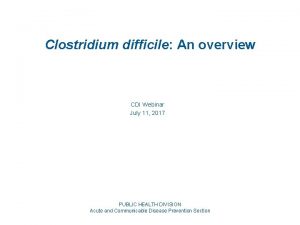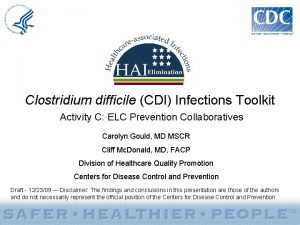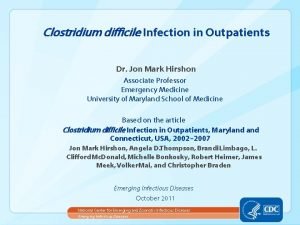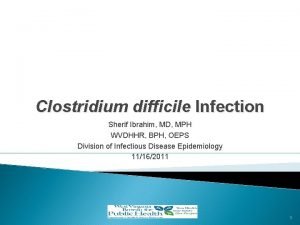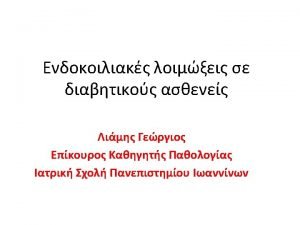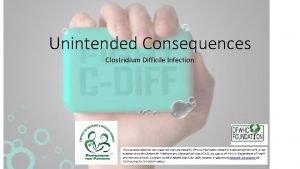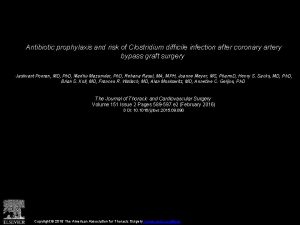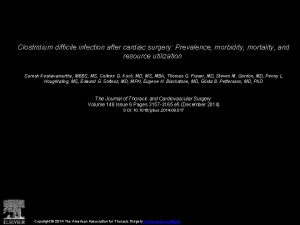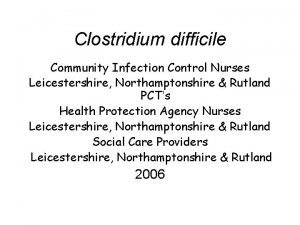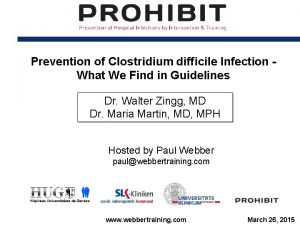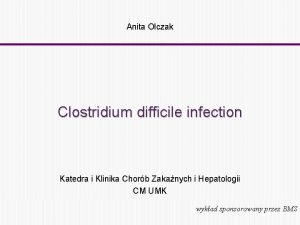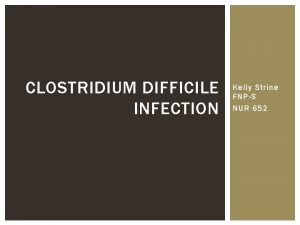Clostridium difficile Infection CDI Guideline Update Understanding the





































- Slides: 37

Clostridium difficile Infection (CDI) Guideline Update: Understanding the Data Behind the Recommendations Erik R. Dubberke, MD, MSPH Associate Professor of Medicine Washington University School of Medicine

Summary of Key Changes from 2010 Guidelines • Epidemiology • 027/NAP 1/BI strain possibly on the mend • Diagnosis • Still not completely satisfying • Infection prevention and control • Nothing really new • Too early to know what to do with asymptomatic carriers • Treatment • Major changes • Should result in improved outcomes

Clostridium difficile • Gram positive, spore forming rod • Obligate anaerobe • Toxin A and Toxin B • Required to cause disease (toxigenic) • 20% to 30% non-toxigenic • C. difficile infection (CDI, formerly CDAD) • Toxigenic C. difficile in stool ≠ CDI • Ubiquitous organism: soil, water, pets, livestock, food, homes of otherwise healthy people, healthy people

CDI Epidemiology • Best surveillance in US: CDC Emerging Infections Program • Seminal paper on CDI published in 2015 • Data from 2011 • Key findings • 147 incident CDI cases / 100, 000 persons • >450, 000 incident cases • >29, 000 associated deaths • More community-onset cases than previously recognized • 027 strain: 31% healthcare-associated CDI, 19% community-associated CDI Lessa. NEJM. 2015

Declines in 027 since 2011 2012 2013 2014 147. 2 145. 8 141. 7 148. 6 027: Healthcare 31% associated (%) 21% 24% 19% 027: Community 19% associated (%) 17% 12% 7%* 8%* Incidence (per 100, 000) 2015 *not most common strain https: //www. cdc. gov/hai/eip/clostridium-difficile. html

Diagnostics Available Test Advantage(s) Disadvantage(s) Toxin testing Toxin Enzyme immunoassay (EIA) Rapid, simple, inexpensive Least sensitive method, assay variability More sensitive than toxin EIA, associated with outcomes Labor intensive; requires 24– 48 hours for a final result, special equipment; Glutamate dehydrogenase (GDH) EIA Rapid, sensitive Non-toxigenic and toxigenic C. difficile detected; Nucleic acid amplification tests (NAAT) (PCR) Rapid, sensitive, detects presence of toxin gene Cost, special equipment, may be “too” sensitive Stool culture Most sensitive test available when performed appropriately Non-toxigenic and toxigenic C. difficile detected; labor-intensive; requires 48– 96 hours for results Tissue culture cytotoxicity Organism identification

Historical Flaws in Diagnostic Literature Interpretation • Lack of clinical data • Test for CDI does not exist: detect toxin or organism • Up to 15% of patients admitted to the hospital are colonized with toxigenic C. difficile • Other reasons for diarrhea are often present • Enhanced sensitivity for C. difficile detection will increase detection of asymptomatic C. difficile carriage • Patients with CDI have more toxin / organism in stool than asymptomatic carriers • Lack of appreciation not all toxin detection assays are equal • Original EIAs: detect toxin A only • Some strains produce only toxin B (as many as 20%) • Manufacturer, target(s) and format make a difference Dubberke. AAC. 2015; Peterson, CID. 2007

Types of False Positive Tests for CDI • Toxigenic C. difficile present but no CDI – Concern of more sensitive tests • GDH • NAAT/PCR • Culture • Assay result positive but toxigenic C. difficile not present – Tests that detect non-toxigenic C. difficile • GDH alone • Culture alone – False positive test

Enhanced Sensitivity to Detect C. difficile Decreases Specificity for CDI • Including clinically significant diarrhea in gold standard: • No impact on sensitivity • NAATs 99% • Techlab Tox AB II 94% • Specificity of NAATs decreased from ~98% to ~89% (p < 0. 01) • Positive predictive value decreased to ~60% (25% drop) • No NAAT (+) / toxin (–) developed CDIrelated complications Dubberke. JCM. 2011;

Largest Assay Comparison To Date Variable Cytotoxicity (CTX) + CTX -/ NAAT + -/- (CTX+ ) vs. (CTX-/NAAT+) (CTX+) vs. (-/-) (CTX/NAAT+) vs. ( -/-) Number 435 311 3943 White blood count (SD) 12. 4 (8. 9) 9. 9 (6. 6) 10. 0 (12. 0) <0. 001 0. 863 Died 72 (16. 6%) 30 (9. 7%) 349 (8. 9%) 0. 004 <0. 001 0. 606 Planche. Lancet ID. 2013

Time to Resolution of Diarrhea Polage. JAMA IM. 2015

Guidelines: Diagnosis Clinical question: What is the preferred population for C. difficile testing, and should efforts be made to achieve this target? • Patients with unexplained and new-onset ≥ 3 unformed stools in 24 hours are the preferred target population for testing for CDI (weak recommendation, very low quality of evidence)

Limitations Noted • Weak supportive data on definition for clinically significant diarrhea • Has changed over time • Other conditions / medications can confound • Suggest ways to improve patient selection: • Clinicians: order tests only on patients likely to have CDI • Laboratories: reject specimens that are not soft/liquid (i. e. take the shape of the container) Author Year Definition Tedesco 1974 > 5 loose BM/day Teasley 1983 > 6 loose BM over 36 hours Fekety 1989 Liquid OR >4 BM per day for ≥ 3 days Johnson 2013 ≥ 3 loose or watery BM in 24 hours Mc. Donald. CID. 2018

Supportive Evidence for Clinicians Pre-test probability (n) Take home messages: Variable Low (n=72) Medium (n=34) High (n=5) Positive toxin EIA 0 • If clinical judgement used: 365% did not 1 Positive toxigenic culture 4 4 1 need to be tested Negative EIA and empiric 0 0 0 treatment • If we used NAAT, 9 “CDI cases” vs. 4 Negative EIA and CDI diagnosed in next 30 days 0 0 0 90 -day mortality 0 1 0 Kwon. JCM. 2017

Real world Both: weak recommendation, low quality of evidence Ideal world

Will Limiting Testing to the “Ideal” World Limit False Positive NAATs for CDI? • 2 years of data: 8, 931 testing episodes • 8, 361 EIA • 570 EIA+ • Patients with • • • Clinically significant diarrhea (≥ 3 diarrheal BM/d or diarrhea plus abd pain) No alternate explanation for diarrhea (e. g. laxatives, tube feeds, colostomy, etc) No recent CDI For EIA-, no treatment for CDI Inpatient

EIA- Stools Total EIA- Stools N=8361 Excluded through Medical Informatics queries N=5809 (69%) Eligible for Chart Review N=2552 (31%) Eligible for culture N=515 (20%) *6% of total EIA- stools* Excluded during chart review N=2037 (80%) Reasons for exclusion: • Medical condition associated with diarrhea • Laxatives • Tube feeds • Ostomy • Chemo • Other infectious etiology • History of CDI • CDI treatment antibiotics Reasons for exclusion: • Outpatient • Unable to determine diarrhea severity • Diarrhea not clinically significant • Other reason for diarrhea • History of CDI Toxigenic culture positive: N=63 (12. 2%)

False Positives in Ideal World Testing Scenario • Same process for EIA+ specimens • 107 (20%) met criteria • 170 total that were EIA+ (107) or EIA- / toxigenic culture+ (63) • Most EIA- / toxigenic culture+ would be NAAT+ • If NAAT used: 63/170 = 37% false positives • Similar to what is seen in real world

European Recommendations: Importance of Toxin Detection and Clinical Evaluation Crobach. Clin Microbiol Infect. 2016

Guidelines: Prevention • Antimicrobial stewardship: best intervention available today • Contact precautions: prevent transmission of C. difficile from patients with CDI • Disinfecting the environment • Screening for asymptomatic C. difficile carriers • Data not there to support recommendation • Needs more study

The C. difficile “Iceberg” CDI 10%-30% Asymptomatic Carriers 70%-90% Courtesy L. Clifford Mc. Donald (note: color changed from original slide)

Asymptomatic Carriers Contribute to CDI • Clabots: 84% of new acquisitions came from an asymptomatic carrier • Lanzas: at least 50% of hospital-onset CDI cases come from asymptomatic carriers • Eyre: transmission from as few as 1% of asymptomatic carriers can account for 50% of CDI cases • Curry: new hospital-onset CDI – 30% from other CDI cases – 29% from known asymptomatic carriers (not all patients screened) Clabots. JID. 1992; Lanzas. ICHE. 2011; Eyre PLo. S One. 2013; Curry. CID. 2013; Mc. Donald. CID. 2013

Screening for Asymptomatic Carriage • Issues to keep in mind • Single center • Recent abstract without significant reduction in CDI • Other potential explanations for reductions in CDI • More successful than models • Lessons learned from MRSA / VRE • Cost/expense/person-time to screen Longtin. JAMA IM. 2016; Peterson. ECCMID. 2018. Abstract 2332; Lanzas. ICHE 2014

Guidelines: Treatment

Initial episode Clinical Definition Supportive Clinical Data Initial episode, WBC ≤ 15, 000 cells/ml, non-severe serum Cr <1. 5 mg/d. L Fidaxomicin now first. Initial episode, >15, 000 cells/ml, line. WBC agent severe serum Cr >1. 5 mg/d. L Initial episode, Hypotension or shock, fulminant ileus, megacolon Minor change to serum creatinine cut-off Recommended Treatment (Strength of Recommendation/ Quality of Evidence) • VAN 125 mg given 4 times daily for 10 days (Strong/High), OR • FDX 200 mg given twice daily for 10 days (Strong/High) • Alternate if above agents are unavailable: metronidazole, 500 mg 3 times per day by mouth for 10 days (Weak/High) • VAN, 125 mg 4 times per day by mouth for 10 days (Strong/High), OR • FDX 200 mg given twice daily for 10 days (Strong/High) • VAN, 500 mg 4 times per day by mouth or by nasogastric tube (Strong/Moderate). If ileus, consider adding rectal instillation of VAN. IV metronidazole (500 mg every 8 hours) (Strong/Moderate) should be administered together with oral or rectal VAN (Weak/Low), particularly if ileus is present. Major change: metronidazole is no longer first line agent for non-severe CDI in settings where access to VAN/FDX is not limited

Metronidazole Inferior For Severe and Non-Severe CDI **P=0. 020, M vs. V Vancomycin superior to metronidazole on multivariable analysis, including controlling for clinical severity (p=0. 013) Johnson S, et al. Clin Infect Dis. 2014; 59: 345 -354.

Fidaxomicin vs Vancomycin Clinical Outcomes in m. ITT Populations • Novel macrocyclic antimicrobial • Narrow spectrum Clinical Outcomes • No activity against Gram-negative agents • Sparing of Bacteroides sp. , Bifidobacterium, clostridial clusters IV and XIV Fidaxomicin, n (%) Vancomycin, n (%) Treatment Difference Clinical cure Louie[a] Cornely[b] 253/287 (88. 2) 221/252 (87. 8) 265/309 (85. 8) 223/257 (86. 7) -3. 1* -4. 9* Recurrence† Louie[a] Cornely[b] 39/253 (15. 4) 28/221 (12. 7) 67/265 (25. 3) 60/223 (26. 9) -9. 9 (-16. 6 to -2. 9) -14. 2 (-21 to -6. 8) P =. 0005 P =. 0002 4/287 (74. 6) 193/252 (76. 6) 21 198/309 (64. 1) 163/257 (63. 4) 10. 5 (3. 1 to 17. 7) 13. 2 (5. 3 to 21) P =. 006 P =. 001 Sustained clinical response* Louie[a] Cornely[b] *Lower boundary 97. 5% CI. † 95% CI. a. Louie TJ, et al. N Engl J Med. 2011; 364: 422 -431; b. Cornely OA, et al. Lancet Infect Dis. 2012; 12: 281 -289. P Value

Recurrence CDI Clinical Definition Recommended Treatment (Strength of Recommendation/ Quality of Evidence) First recurrence • VAN 125 mg given 4 times daily for 10 days if metronidazole was used for the initial episode (Weak/Low), OR Do not give same • Use a prolonged tapered and pulsed VAN regimen if a standard regimen was used for the initial episode (Weak/Low), OR regimen a second time • FDX 200 mg given twice daily for 10 days if VAN was used for the initial Episode (Weak/Moderate) Second or subsequent recurrence • VAN in a tapered and pulsed regimen (Weak/Low), OR • VAN, 125 mg 4 times per day by mouth for 10 days followed by rifaximin 400 mg 3 times daily for 20 days (Weak/Low), OR • FDX 200 mg given twice daily for 10 days (Weak/Low), OR • Fecal microbiota transplantation (Strong/Moderate) (appropriate antibiotic treatments for at least 2 recurrences (ie, 3 CDI episodes) should be tried prior to offering fecal microbiota transplantation) More options provided for second or subsequent recurrence

What about Bezlotoxumab? • Monoclonal antibody against C. difficile toxin B • Administered as single IV infusion in addition to standard of care CDI treatment antibiotics • Indication: prevention of recurrent CDI 60 49. 5 50 39. 4 40 30 20 41. 1 36. 0 31. 6 19. 3 19. 0 31. 5 28. 2 15. 9 10 0 Age ≥ 65 yrs Hx CDI† Immunocompromised‡ Bezlo Placebo Severe CDI§ RT 027/078/244� Percent Participants with CDI Recurrence • Results not available early enough to be included 60 50 37. 2 40 30 20 31. 3 18. 8 20. 9 46. 1 41. 1 21. 2 26. 9 21. 2 17. 1 10 0 No risk factors ≥ 1 risk factor Bezlo 1 risk factor 2 risk factors ≥ 3 risk factors Placebo Gerding. CID. 2018

How Can the Microbiology Laboratory Help? • CDI prevention multidisciplinary • • • Infection Prevention and Control Antimicrobial Stewardship Program Clinicians Nurses Housekeeping • Microbiology laboratory: necessary piece • Time to diagnosis of CDI • Laboratory-based approaches to minimize false positives • Improve antimicrobial prescribing

Greatest Risk of Transmission Early • Highest risk period for C. difficile transmission • Not in contact precautions Sethi. ICHE. 2010

Potential Delays to Avoid • Mean days from diarrhea onset to • Order: 1. 4 days • Physician awareness • Nursing awareness • Result: 3. 2 days • Time from order to collection • Frequency of testing Kundrapu. JCM. 2013

Minimize False Positive Tests for CDI • False positives lead to: • Unnecessary antimicrobial use • Promotes spread of resistant bacteria • Paradoxically may increase risk for CDI once stopped • Unnecessary contact precautions • Patient anxiety / satisfaction • Increase in adverse events • Lack of investigation for other causes of diarrhea • Diversion of limited resources • Masks impact of CDI prevention activities • Hospital may lose reimbursement from high CDI rates

Interventions to Minimize False Positive Tests • DO NOT TEST FORMED STOOLS • No diarrhea = No CDI • Do not allow test of cure • Not predictive of treatment success or risk of recurrent CDI • Do not allow automatic repeat testing • Most positive tests on repeat testing are false positives • Educate nurses and physicians on patient selection for testing • Diarrhea: • Clinically significant, no other cause: test ASAP (consider contact precautions) • Not clinically significant or alternate explanation (i. e. low pre-test probability): do not test • Educate on test used at your facility • And always remind people: C. difficile test, NOT CDI test

Different Testing Strategies and False Positives • Hypothetical scenarios • Toxin EIA: sensitivity 85%, specificity 97% • NAAT: sensitivity 99%, specificity 89% (CDI) • GDH: sensitivity 99% (ignore specificity) • Test 1, 000 patients, 100 with CDI (10% prevalence) Testing strategy True positives False positives Toxin EIA only NAAT only 85 99 27 99 NAAT or GDH (+) then Toxin EIA 84 3

Assist in Antimicrobial Stewardship • Improve test utilization related to infections • Order of tests in drop down list • Most appropriate test first • Reflex urine cultures: >10 WBC / high power field • Rapid diagnostics • MALDI • Rapid tests for resistance mechanisms • Respiratory multiplex PCRs Barlam. CID. 2016; Sarg. ICHE. 2016; Subramony. J Pediatr. 2016

Conclusions: 2017 Guideline Update • CDI epidemiology is changing • 027 strain may be declining • Testing recommendations still with weak supportive data • Improve patient selection • In most scenarios, toxin testing helpful • Antimicrobial stewardship best available CDI prevention intervention • Screening for asymptomatic carriage: research for now • Major changes to treatment recommedations • Metronidazole no longer first-line agent • Fidaxomicin is a first-line agent • The microbiology lab is a key component to CDI prevention efforts
 Database backup and recovery techniques
Database backup and recovery techniques Un difficile dopoguerra
Un difficile dopoguerra Puzzle difficile
Puzzle difficile Pinza di magill intubazione endotracheale
Pinza di magill intubazione endotracheale G'ra'd'le
G'ra'd'le Synthese document
Synthese document Forti et fideli nihil difficile
Forti et fideli nihil difficile Clostridium welchii
Clostridium welchii Lofotrica
Lofotrica Morfologi clostridium perfringens
Morfologi clostridium perfringens Microbiology
Microbiology Measles vs chicken pox
Measles vs chicken pox Frotis y cultivo
Frotis y cultivo Clostridium perfringens
Clostridium perfringens Differentiate rigor mortis from cadaveric spasm
Differentiate rigor mortis from cadaveric spasm Stately motility seen in
Stately motility seen in Medio de cultivo para clostridium perfringens
Medio de cultivo para clostridium perfringens Clostridium perfringens sintomas
Clostridium perfringens sintomas Clostridium tetani
Clostridium tetani Clostridium spores
Clostridium spores Clostridium botulinum reino
Clostridium botulinum reino Parede celular
Parede celular Robertsons cooked meat medium
Robertsons cooked meat medium Clostridium sporogenes
Clostridium sporogenes L
L Botulinum
Botulinum Clostridium tetani
Clostridium tetani Clostridium perfringens lecithinase
Clostridium perfringens lecithinase Cdi icd10
Cdi icd10 Holly forester miller
Holly forester miller Cdi supply chain
Cdi supply chain High bdi low cdi
High bdi low cdi Cdi ex libris
Cdi ex libris Cdi cleaning services
Cdi cleaning services Mi cdi
Mi cdi Design thinking cdi
Design thinking cdi Bdi cdi
Bdi cdi Cdi lasten masennuskysely
Cdi lasten masennuskysely


